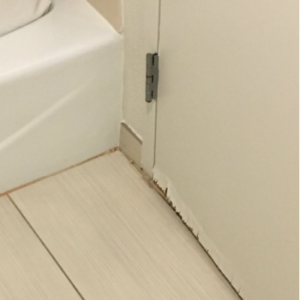I Love to Paint!

I love to paint. No, not the Pablo Picasso or Leonardo da Vinci type of painting. I enjoy painting interior walls or exterior siding, soffit, and trim. A nice paint job is usually the last step in a home improvement or repair process. So, the paint can make the job look really good or really bad. Below are some old, but still relevant, tips and insight on wood paint from the USDA that I recently ran across in my files.
Paint is probably the most common exterior finish in use on wood today. It appears somewhere on practically every house and most commercial buildings. Even brick and aluminum sided houses usually have some painted wood trim. When properly applied to the appropriate type of wood substrate, paint can give a service life of up to 10 years. All too often, however, problems may develop during the application of the paint or the paint coat fails to achieve the expected service life. Paint properly applied and exposed under normal conditions is not affected by the first two to three years of exposure. Areas which deteriorate the fastest are those exposed to the greatest amount of sunshine and rain, usually on the south and west sides of a building. The normal deterioration process leads first to soiling or slight accumulation of dirt, and then to a flattening stage when the coating gradually starts to chalk and erode away. However, early paint failure may develop under certain abnormal conditions of service. Excess moisture, flat-grained wood, high porosity in paint and applying a new paint coat without proper preparation of the old surface can all lead to early paint failure. The most common cause of premature paint failure on wood is moisture. Paint on the outside walls of houses is subject to wetting from rain and dew. Equally as serious is “unseen” moisture moving from inside the house to the outside.
Outside moisture such as rain and dew can penetrate a paint coat and result in cracking, peeling, discoloration and premature paint failure. These problems may be observed in both heated and unheated buildings, are more pronounced on edges and ends of boards, especially in the early stages of paint failure, and are also observed where water is held on the surface. Problems often occur below roof valleys and corners where rain runoff from the roof wets the side wall excessively and below horizontal roof edges and roof valleys where ice dams develop. Porous paints are particularly vulnerable to moisture penetration. Proper construction and maintenance will eliminate most exterior water problems. Adequate overhangs protect at least the upper portion of the house and properly maintained gutters prevent rain water splash. Flashing must be used at roof and wall junctions, around chimneys, over exposed doors and windows, where siding materials change, in roof valleys, on roof edges and other areas where moisture may penetrate into the house.

Inside moisture (water vapor) can destroy paint on the outside of a building by diffusing through the walls. Water vapor from cooking, dishwashing, clothes dryers, bathing and normal respiration by an average family of four can contribute three gallons of water per day to the humidity. Additional sources are humidifiers, unvented gas heaters and moisture moving into the living quarters from crawl spaces and wet basements. If the inside of all exterior walls does not
have a vapor barrier or if the vapor barrier is improperly installed, water vapor passes into the walls during cold winter weather and condenses to a liquid. In very cold weather, it may form frost and melt as warm weather approaches. The water eventually soaks into the siding and wets the paint and is a common cause of blistering and peeling. The problem may be particularly pronounced around bathrooms, laundry rooms, kitchens and other areas of high humidity. Interior water vapor can also move into the attic space and condense on the gable ends, causing paint peeling, Moisture may also condense on the attic side of the roof decking and eventually work its way down the side walls, causing paint peeling near the tops of these walls. To prevent condensation problems in the attic, it should be well ventilated. Gable roofs should have screened vent areas of at least one square foot per 300 square feet of ceiling area. Hip roofs should have continuous slotted vents in the eaves to allow air to enter the attic and ridge vents to allow its exit. Condensation problems in cold climates are best prevented by installation of a continuous 6 mil polyethylene vapor barrier on the warm aide of all exterior walls and ceilings. The vapor barrier should fit tightly around electrical outlets, doors, windows and other openings. A vapor barrier, sometimes called a soil cover, should be installed directly over the soil in all houses with crawl spaces. This will keep moisture from moving out of the soil and up into the living space and then through the walls and ceilings. If a vapor barrier is absent, it can be installed under new paneling or dry wall. Two coats of alkyd resin paint or plastic-faced hard board, and similar materials, may serve as a vapor barrier when applied over the existing walls. It should be recognized that these methods are generally not as effective as a properly installed vapor barrier of the film type.
To reduce water vapor in the house, vent high humidity areas such as kitchens and bath areas to the outside. Clothes dryers should be vented directly to the outside and not to the attic, basement or crawl space. Mechanical humidifiers add large quantities of moisture to the air and should not be used if paint peeling is a problem.
Meet the Author
Dr. Todd Shupe is the President of Wood Science Consulting, LLC. He is a well-recognized expert on wood forensics, wood preservation, wood decay and degradation, and wood species identification. He has a broad background in new product development, quality management, and marketing and sales in both the public and private sectors. For more information please visit DrToddShupe.com.
We welcome your comments below.
Thank you for visiting. We trust that you have enjoyed reading our articles.
Liked this post? Read more below or search for more topics . . .

